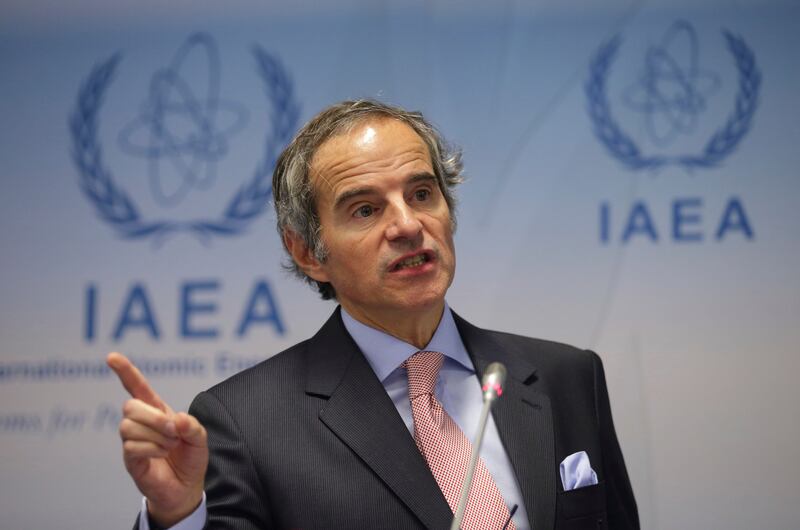The head of the UN nuclear watchdog said on Tuesday his attempt to broker a deal to protect Ukraine’s Russian-occupied Zaporizhzhia nuclear plant was still alive, and that he was adjusting the proposals to seek a breakthrough.
Rafael Grossi, head of the International Atomic Energy Agency, spoke to Reuters a day before he is expected to travel to Europe’s largest nuclear power station in the Russian-occupied Zaporizhzhia region of southeastern Ukraine.
Mr Grossi has been pushing for a safety zone to be created at the plant to prevent a possible nuclear disaster as Moscow and Kyiv have accused each other of shelling the site of the power station since Russia invaded Ukraine in February last year.
“We are making some adjustments on the proposals that we are putting on the table,” Mr Grossi said in an interview in the central Ukrainian city of Dnipro.
READ MORE
“I am confident that it might be possible to establish some form of protection, perhaps not emphasising so much the idea of a zone, but on the protection itself: what people should do or shouldn’t do to protect [the plant] instead of having a territorial concept.”
The contours of the proposed deal have not been made public.
Diplomats say Mr Grossi’s latest proposal no longer includes a defined radius around the plant to mark the zone.
Ukraine does not want a deal that will in effect recognise or allow a Russian military presence at the plant. Other elements of Mr Grossi’s plan include no firing at or from the plant, and the removal of heavy weapons.
“I am not giving up in any way. I think on the contrary we need to multiply our efforts, we need to continue,” Mr Grossi said.
He said there had been increasing military activity in the region without giving details.
Mr Grossi, who met President Volodymyr Zelenskiy on Monday, described the situation at the plant as “very dangerous” and very unstable. It has lost its external power supply six times since Russia’s invasion, forcing emergency diesel generators to kick in to cool its reactors.

Mr Grossi said the water level in a nearby reservoir controlled by Russian forces was another potential danger. Water supplied by the reservoir is used to cool the reactors.
“If the reservoir level goes down beyond a certain level, then you don’t have water to cool down the reactors, and we have seen, especially in January, that the levels of the water were going down significantly. They recovered somehow in the past few weeks,” he said.
The IAEA has had its own monitors stationed at the Zaporizhzhia plant since last year. Mr Grossi blamed a recent delay in their rotation on a row between Russia and Ukraine over the route they were supposed to take.
“We had an agreed route. All of a sudden that route was not agreed any more . . . It took an awful lot of time to come to an agreement,” he said.
Ukrainian forces killed two civilians late on Monday when they shelled an apartment building in the Russian-held city of Donetsk in eastern Ukraine, Russian-installed officials said on Tuesday.
Reuters reporters saw rescue workers combing through the rubble in the building, the lower part of which had collapsed, and one victim’s legs protruding from the debris.
“A Ukrainian shell struck an apartment building at 246 Kuybyshev Street [in Donetsk],” the Russian-installed police force in the part of Ukraine’s Donetsk region controlled by Moscow said in a statement.
“Unfortunately, two civilians died of their wounds under the rubble of the damaged building.”
There was no immediate comment from Ukrainian authorities, who say Russian forces have killed thousands of people in similar attacks on civilian areas and that their own armed forces are trying to seize back control of Ukrainian territory.
Moscow, which says it does not deliberately target civilians, is trying to take control of all of Ukraine’s Donetsk region, a big chunk of which it has already seized, and is facing fierce resistance from the Ukrainian army.
Meanwhile Russia has test-fired anti-ship missiles in the Sea of Japan.
The Russian defence ministry said that two ships launched a simulated missile attack on a mock enemy warship about 96km away.
A spokesman said the target was successfully hit by two Moskit cruise missiles.
The Moskit, whose Nato reporting name is the SS-N-22 Sunburn, is a supersonic anti-ship cruise missile that has conventional and nuclear warhead capacity.
It said the exercise took place in the Peter the Great Gulf in the Sea of Japan but did not give more precise co-ordinates.
The Gulf borders the Russian Pacific Fleet headquarters at Fokino and is about 430 miles from Japan’s northern Hokkaido Island.
Japan does not plan to lodge a protest to Russia over the missile exercise, said Tasuku Matsuki, a Japanese foreign ministry official, noting that its location is considered Russian coast, although it is facing the water between the two countries.
“On the whole, Japan is concerned about Russia’s increasing military activities around the Japanese coasts and watching them with great interest,” Mr Matsuki said.
He said Russia has conducted missile drills in that area in the past and issued maritime advisories in advance of tests.
Russian nuclear-capable Tu-95 bombers flew over the Sea of Japan for several hours last week.
In September, Japan protested over multinational military exercises on the Russian-held Kuril Islands – some of which are claimed by Japan – and expressed concern about Russian and Chinese warships conducting shooting drills in the Sea of Japan.
Russia also tested submarine-launched missiles in the Sea of Japan last year. – Reuters/AP














